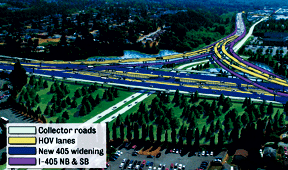 |
| TIED UP Officials keep up fight to fund decongestion projects in Seattle area. |
Washington state officials, stung by last month's voter rejection of an initiative that would have used a 9 fuel tax increase to fund transportation improvements, are looking for new ways to prioritize major projects--and pay for them.
The city of Seattle is moving ahead with a monorail system, but overall state transportation planning remains mired in politics. State and transportation officials are visiting community groups to gauge what voters want and how much they're willing to pay.
"It's the end of act one," says David Dye, administrator of the state Dept. of Transportation's Seattle-based Urban Corridors office, formed by the state legislature to develop strategies for urban megaprojects. "Now, we're rolling up our sleeves and starting act two."
Known as Referendum 51, the statewide fuel tax would have generated $7.8 billion over 10 years, including $1.77 billion for Interstate 405, $100 million for a wider Highway 520 Evergreen Point Floating Bridge, and $450 million for an improved Alaskan Way Viaduct. Funds also would have come from a surcharge on vehicle purchases and a weight-fee increase for large trucks.
"R-51 failed, but the play isn't over yet," Dye says. Through January, DOT and the Washington State Transportation Commission (WSTC) will seek support for a new 10-year infrastructure plan. After gauging voters' attitudes, DOT will choose from $7-billion, $8-billion and $10-billion options to take back to them.
Gov. Gary Locke (D) also has called R-51 players together for a conference in Olympia next week. "The regional package is moving to the forefront," says Sen. Jim Horn, incoming chair of the state Senate transportation committee. "There are also [other] projects that need to be done."
The Regional Transportation Investment District of King, Pierce and Snohomish counties hopes to put a road-and-transit package on the November 2003 ballot and plans to ask the legislature for permission to propose a regional fuel tax of 4 to 6 a gallon. "We've had to cut back after the loss of funding from R-51, but we can't sit still hoping the legislature will provide funding," says RTID board member Rob McKenna.
Some projects left without funding after the November election are deemed critical. Engineers say a storm of 92-mph winds has a 20% chance of crippling the aging floating bridge, and a severe earthquake could collapse the viaduct. Officials estimate it would cost up to $2.9 billion to rebuild the viaduct, $3.3 billion to replace it and $4.7 billion to construct a tunnel.
R-51 also would have funded HOV lanes and improvements to Interstates 5, 90 and 405, and other major routes. It also targeted the most dangerous of 950 bridges and 2,037 highway locations, and would have provided $50 million in seed money for projects planned by RTID.
But it won only 38% of the vote. Then, voters passed Initiative 776, repealing a $15 surcharge on vehicle registration and cutting license-tab fees to $30 a year, effectively slicing another major funding source. King and Pierce counties and the City of Tacoma have sued, and so will the board of Sound Transit, the Seattle area transit agency. A Jan. 31 hearing will decide whether the new law is constitutional.
The initiative could cost Puget Sound area governments and agencies $380 million in tax revenue over 10 years. But Sound Transit transportation agency is encouraged that 56.6% of voters in five counties rejected the initiative, as did 70.8% of Seattle voters. "That's clearly an affirmation of what we're trying to do," says spokesperson Geoff Patrick.
With a high state unemployment rate, "to ask (voters) to increase taxes on themselves was asking a lot," says Todd Webster, press secretary for Sen. Patty Murray, top-ranking Democrat in the transportation appropriations subcommittee.
State DOT numbers show that Washington's $120-per-person annual investment in highways in 2001 ranked 46th in the nation. The 2001 national median was $169. Washington now has a 10-year funding capacity of $4.8 billion--an average of $80 per person per year.
Now that Seattle voters approved construction of a monorail line, some are looking at the potential to tie the futuristic city-wide system in with regional light rail. But many believe the systems will suffocate each other under current planning and management structures. "The big question is how decisions will be made on what resources are going to be allocated to whom," says Aubrey Davis, WSTC chairperson. "Our political system isn't structured well to do that."
Seven agenciesamong them Sound Transit, the Seattle Popular Monorail Authority and RTIDregulate transportation in the Puget Sound region. The Transportation Choices Coalition and the Discovery Institute, a pro-business think tank, are calling for a single umbrella agency. "At the very least, the agencies need to get together and come up with a coordinated plan," says Bruce Agnew, director of the Discovery Institute's Cascadia Transportation Project. "We have a system that's incredibly balkanized, and with the passage of the monorail it's becoming even more balkanized."
"We need all the multimodal transportation we can get, but having one agency to coordinate it would be a good thing," agrees Tim Bevan, project manager with CH2M Hill Cos.' local office.


Post a comment to this article
Report Abusive Comment